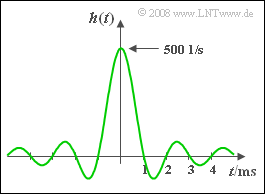Exercise 1.5Z: Sinc-shaped Impulse Response
From LNTwww
The impulse response of a linear time-invariant (and non-causal) system was determined as follows (see graph):
- $$h(t) = 500\hspace{0.1cm}{ {\rm s}}^{-1}\cdot{\rm sinc}\big[{t}/({ 1\hspace{0.1cm}{\rm ms}})\big] .$$
The output signals $y(t)$ should be computed if various cosine oscillations of different frequency $f_0$ are applied to the input:
- $$x(t) = 4\hspace{0.05cm}{\rm V}\cdot {\rm cos}(2\pi \cdot f_0 \cdot t ) .$$
Please note:
- The exercise belongs to the chapter Some Low-Pass Functions in Systems Theory.
- The solution can be found in the time domain or in the frequency domain. In the sample solution you will find both approaches.
- The following definite integral is given:
- $$\int_{ 0 }^{ \infty } \frac{\sin(u) \cdot \cos(a \cdot u)}{u} \hspace{0.15cm}{\rm d}u = \left\{ \begin{array}{c} \pi/2 \\ \pi/4 \\ 0 \\ \end{array} \right.\quad \quad \begin{array}{c} {\rm{f\ddot{u}r}} \\ {\rm{f\ddot{u}r}} \\ {\rm{f\ddot{u}r}} \\ \end{array}\begin{array}{*{20}c}{ |a| < 1,} \\{ |a| = 1,} \\ { |a| > 1.} \\ \end{array}$$
Questions
Solution
(1) A comparison with the equations on the page Idealer Tiefpass or applying the Fourierrücktransformation shows that $H(f)$ is an ideal low-pass filter:
- $$H(f) = \left\{ \begin{array}{c} \hspace{0.25cm}K \\ K/2 \\ 0 \\ \end{array} \right.\quad \quad \begin{array}{*{10}c} {\rm{f\ddot{u}r}} \\ {\rm{f\ddot{u}r}} \\ {\rm{f\ddot{u}r}} \\ \end{array}\begin{array}{*{20}c} {\left| \hspace{0.005cm} f\hspace{0.05cm} \right| < \Delta f/2,} \\ {\left| \hspace{0.005cm}f\hspace{0.05cm} \right| = \Delta f/2,} \\ {\left|\hspace{0.005cm} f \hspace{0.05cm} \right| > \Delta f/2.} \\ \end{array}$$
- The equidistant zero-crossings of the impulse response occur at an interval of $Δt = 1 \ \rm ms$ .
- From this it follows that the equivalent bandwidth is $Δf \rm \underline{ = 1 \ \rm kHz}$.
- If $K = 1$ was true, then $h(0) = Δf = 1000 \cdot \rm 1/s$ should hold.
- Because of the given $h(0) = 500 \cdot{\rm 1/s} = Δf/2$ the direct signal (DC) transmission factor thus is $K = H(f = 0) \; \rm \underline{= 0.5}$.
(2) Diese Aufgabe lässt sich am einfachsten im Spektralbereich lösen.
- Für das Ausgangsspektrum gilt: $Y(f) = X(f)\cdot H(f) .$
- $X(f)$ besteht aus zwei Diracfunktionen bei $± f_0$, jeweils mit Gewicht $A_x/2 =2 \hspace{0.08cm}\rm V$.
- Bei $f = f_0 = 1 \ {\rm kHz} > Δf/2$ ist aber $H(f) = 0$, so dass $Y(f) = 0$ und damit auch $y(t) = 0$ ist ⇒ $\underline{y(t = 0) = 0}$.
Die Lösung im Zeitbereich basiert auf der Faltung:
- $$y(t) = x (t) * h (t) = \int_{ - \infty }^{ + \infty } {h ( \tau )} \cdot x ( {t - \tau } ) \hspace{0.1cm}{\rm d}\tau.$$
- Zum Zeitpunkt $t = 0$ erhält man unter Berücksichtigung der Symmetrie der Cosinusfunktion:
- $$y(t = 0 ) = \frac{A_x \cdot \Delta f}{2} \cdot \int_{ - \infty }^{ + \infty } {\rm si} ( \pi \cdot \Delta f \cdot \tau ) \cdot {\rm cos}(2\pi \cdot f_0 \cdot \tau ) \hspace{0.1cm}{\rm d}\tau.$$
- Mit der Substitution $u = π · Δf · τ$ kann hierfür auch geschrieben werden:
- $$y(t = 0 ) = \frac{A_x }{\pi} \cdot \int_{ 0 }^{ \infty } \frac{\sin(u) \cdot \cos(a \cdot u)}{u} \hspace{0.15cm}{\rm d}u .$$
- Hierbei ist die Konstante $a = 2f_0/Δf = 2$. Mit diesem Wert liefert das angegebene Integral den Wert Null: $y(t = 0 ) = {A_y } = 0.$
(3) Der Frequenzgang hat bei $f = f_0 = 100 \ \rm Hz$ nach den Berechnungen zur Teilaufgabe (1) den Wert $K = 0.5$. Deshalb ergibt sich
- $$A_y = A_x/2 = 2\ \rm V.$$
- Zum gleichen Ergebnis kommt man über die Faltung nach obiger Gleichung.
- Für $a = 2f_0/Δf = 0.2$ ist das Integral gleich $π/2$ und man erhält
- $$y(t = 0 ) = {A_y } = \frac{A_x}{\pi} \cdot \frac{\pi}{2} = \frac{A_x}{2} \hspace{0.15cm}\underline{= 2\,{\rm V}}.$$
(4) Genau bei $f = 0.5 \ \rm kHz$ liegt der Übergang vom Durchlass– zum Sperrbereich und es gilt für diese singuläre Stelle:
- $$H(f = f_0) = K/2.$$
- Somit ist die Amplitude des Ausgangssignals nur halb so groß wie in der Teilaufgabe (3) berechnet, nämlich $A_y \; \underline{= 1 \, \rm V}$.
- Zum gleichen Ergebnis kommt man mit $a = 2f_0/Δf = 1$ über die Faltung.
